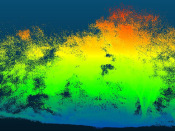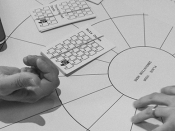Por Bruno Loff (Universidade do Porto).
I will give a board-and-chalk-and-informal-talk presentation about the difficulty of proving lower-bounds in computational complexity.
The P vs NP problem is one of the most famous unsolved problems in mathematics. One may phrase the P vs NP question in various equivalent ways. One way, which is not completely equivalent, but almost, is the following ("P/poly vs NP problem"). Does there exist a small Boolean circuit which solves the CLIQUE problem? I.e., does there exist a poly(N)-size Boolean circuit which, when given as input the NxN adjacency matrix of an undirected graph, decides whether the graph has a clique of size N/2?
Complexity theorists, me included, believe that the answer is no. We believe that there exists a super-polynomial "lower-bound" on the complexity of CLIQUE. Many people have tried proving such a lower-bound, and so far all have failed. But why? Why is the problem so difficult?
In the late 1980s, Alexander Razborov proved that there exist no poly(N)-size "monotone" circuits for solving CLIQUE. Namely, if we forbid the Boolean circuit from doing negations, so they can only do ORs and ANDs, then polysize circuits cannot solve the CLIQUE problem. He (and many others) then tried to prove the same result for ordinary circuits (with negation gates). And he failed (and they all failed, too). But along the way he (and many others) proved many different lower-bounds. Lower-bounds for simpler kinds of circuits (e.g. constant-depth), lower-bounds for communication protocols (a different but related computational model), and lower-bounds for other models. Razborov proved these lower-bounds, and he also thought long and hard about why lower-bounds against Boolean circuits were so difficult to prove.
In 1994, Razborov and Stephen Rudich presented their paper, "natural proofs", which had a very reasonable explanation for why circuit lower-bounds were difficult to prove. They showed, remarkably, that every single lower-bound proof that was known at the time had a certain "logical structure" (or could be made to have such a structure by small changes to the argument). This logical structure made the proof very simple and natural, and they called proofs with such a structure "natural proofs". Then they showed that super-polynomial lower-bounds on CLIQUE cannot be shown using natural proofs, unless certain cryptographic primitives, such as factoring, are unsecure. This is a kind of informal independence result. (Based on the natural proofs result, Razborov also later proved formal independence results, showing that P vs NP is independent of certain weak systems of arithmetic, but I do now know the details of those.)
In one fell swoop, Razborov and Rudich ruled out every single lower-bound technique known at the time, saying: these techniques are not enough to solve the P vs NP problem (unless cryptography is insecure). To a very large extent this barrier still applies today, as almost all the lower-bound proofs that we know are natural proofs, i.e., they have the very same logical structure as the proofs known since the 1980s.
In this seminar, I will explain what is a "natural proof", and why it is reasonable to expect that no natural proof can solve the P vs NP problem. Only a few words will be said about some of my research and how it connects to this topic.
Zoom | Meeting ID: 837 8989 1971











